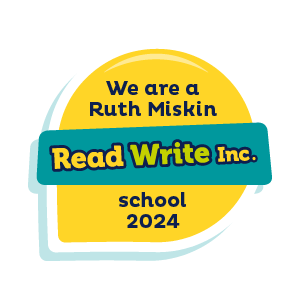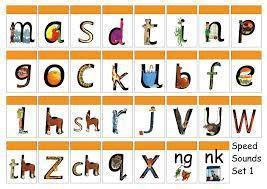Here at Ham Dingle we passionately believe that all children should learn to read before they read to learn. We are determined that every pupil will learn to read regardless of background, needs or abilities. For that very reason early reading is taught through the delivery of ‘Read, Write Inc’ Phonics.

Read Write Inc. Phonics is a complete literacy programme, for 3 to 7 year-olds learning to read and write and for 7 and 8 year-olds needing to catch up quickly. Although reading is taught using synthetic phonics, the programme is so much more than that. It covers all of the new National Curriculum requirements for language and literacy.
What is Phonics?
Words are made up from small units of sound called phonemes. Phonics teaches children to be able to listen carefully and identify the phonemes that make up each word. This helps children to learn to read and spell words.
In phonics sessions children are taught three main skills:
Skill 1. Grapheme Phoneme Correspondences (GPCs)
Children are taught GPCs. This simply means that they are taught all the phonemes (sounds) in the English language and ways of writing them down (letters).
Some graphemes can represent more than one phoneme. For example, ‘ch’ makes very different sounds in these three words: chip, school, chef.
Skill 2. Blending
Children are taught to be able to blend. This is when children say the sounds that make up a word and are able to merge the sounds together until they can hear what the word is.
This skill is vital in learning to read.
Skill 3. Segmenting
Children are also taught to segment. This is the opposite of blending. Children are able to say a word and then break it up into the phonemes that make it up.
This skill is vital in being able to spell words.
Programme progression:
In Reception all children will learn how to ‘read’ the sounds in words and how those sounds can be written down.
Reading
The children:
- learn 44 sounds and the corresponding letters/letter groups using simple picture prompts – see below
- learn to read words using Fred talk (see below) and sound blending
- read from a range of storybooks and non-fictions books matched to their phonic knowledge
- work well with partners
- develop comprehension skills in stories by answering 'Find It' and 'Prove It' discussion questions
Writing
The children:
- learn to write and form the letters/letter groups which represent the 44 sounds with the help of fun phrases
- learn to write words by using Fred Talk
- learn to build sentences by practising sentences out loud before they write
Talking
The children
- They work in pairs so that they:
- answer every question
- practise every activity with their partner
- take turns in talking and reading to each other
- develop ambitious vocabulary
Year One
Children follow the same format as Reception but will work on complex sounds and read books appropriate to their reading level. Once children become fluent speedy readers. They are taught the sounds in 3 sets
Step 1:
Set 1 Sounds are taught in the following order together with rhymes to help children instantly recognise sounds ready for blending.
m, a,s,d,t,i,n,p,g,o,c,k,u,b,f,e,l,h,sh,r,j,v,y,w,th,z,ch,qu,v,ng,nk
Children will also use pictures for each sound to help recognise the sound

Step 2:
The children are then taught Set 2 Sounds - the long vowels. When they are very confident with all of set 1 and 2 they are taught Set 3 Sounds.
| Long vowel sound |
Set 2 Speed Sound cards
Teach these first
|
Set 3 Speed Sound cards |
|
|
ay
|
ay: may I play
|
a-e: make a cake
|
ai: snail in the rain
|
|
ee
|
ee: what can you see
|
ea: cup of tea
|
e: he me we she be
|
|
igh
|
igh: fly high
|
i-e: nice smile
|
|
ow
|
ow: blow the snow
|
o-e: phone home
|
ao: goat in a boat
|
|
oo
|
oo: poo at the zoo
|
u-e: huge brute
|
ew: chew the stew
|
|
oo
|
oo: look at a book
|
|
|
|
ar
|
ar: start the car
|
|
|
|
or
|
or: shut the door
|
aw: yawn at dawn
|
|
|
air
|
air: that’s not fair
|
are: share and care
|
|
|
ir
|
ir: whirl and twirl
|
ur: nurse for a purse
|
er: a better letter |
|
ou
|
ou: shout it out
|
ow: brown cow
|
|
|
oy
|
oy: toy for a boy
|
oi: spoil the boy
|
|
|
ire
|
|
ire: fire fire!
|
|
|
ear
|
|
ear: hear with your ear
|
|
|
ure
|
|
ure: sure it’s pure?
|
|
Nonsense words (Alien words)
As well as learning to read and blend real words children will have plenty of opportunities to apply their sound recognition skills on reading ‘Nonsense words’. These words will also feature heavily in the Year One Phonics Screening check in the summer term.
Fred Talk
What is Fred Talk?
Teachers will introduce your child to a toy frog called Fred once he or she is ready to start reading words.
Fred can only say the sounds in a word and needs your child to help him read the word. Fred will say the sounds and children will work out the word.
For example, Fred will say the sounds c–a–t, and children will say the word cat. This is Fred Talk: sounding out the word.
The following video is an example of blending sounds with Fred.